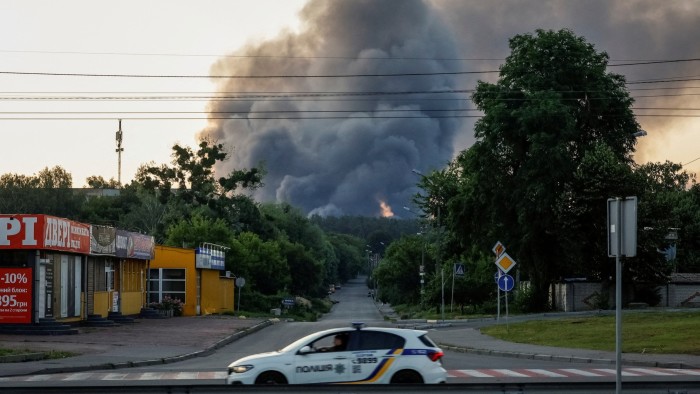Stay informed with free updates
Simply sign up to the War in Ukraine myFT Digest — delivered directly to your inbox.
Russia launched its largest-ever drone and missile barrage on Ukraine, two days after the US stopped the delivery of some key weapons to Kyiv — including crucial interceptors used to shoot down Moscow’s missiles.
A record 539 Iran-designed drones as well as 11 cruise and ballistic missiles were used in an attack that primarily targeted Ukraine’s capital, the country’s air force said on Friday morning. Russia has stepped up its bombardments in recent days, launching its previous largest aerial assault last weekend.
City authorities said 23 people were injured in the attack.
The barrage began soon after an hour-long phone call between US President Donald Trump and his Russian counterpart Vladimir Putin. Trump told reporters the two presidents did not get any closer to a deal to end the war.
“I didn’t make any progress with him today at all,” Trump said of Putin before boarding Air Force One.
Ukrainian President Volodymyr Zelenskyy said on X that the timing of the barrage — straight after Trump and Putin’s call — showed Russia “has no intention of ending the war and terror”, adding: “Without truly large-scale pressure, Russia will not change its dumb, destructive behaviour.”
Ukraine was blindsided this week by the US decision to pause deliveries of several important weapons systems, including missiles for the advanced Patriot anti-air systems. Zelenskyy will discuss the suspension in a call with Trump on Friday or in the coming days, he said on Thursday.

Zelenskyy will also aim to convince Trump to resume the deliveries and to allow Ukraine to buy more Patriot systems. The issue is becoming critical for Ukraine as Russia increases its long-range strikes.
Waves of drones circled Kyiv overnight before diving and exploding in industrial and residential areas, leading to now-familiar scenes of frightened residents gathering in metro stations or hiding in bathrooms.
The capital found itself engulfed in acrid smoke in the morning.
“Launched immediately following the call between Washington and Moscow, this was one of the most severe assaults of the entire war, a clear demonstration of how Moscow interprets diplomacy,” Ukraine’s first deputy prime minister Yulia Svyrydenko wrote on X.
Russian drone strikes had also begun targeting Ukrainian mobilisation centres, Ukraine’s military said on Thursday. The new tactic aims to disrupt Kyiv’s recruitment efforts while Russia maintains its offensive along the entire frontline.
Daylight footage showed three Russian drones plunging one after the other into a mobilisation office in the country’s east, killing two men.
Russia has gradually upgraded its Iran-designed kamikaze drones, increasing their range, payload and cruising altitude. Ukraine is increasingly struggling to deal with the mounting threat, as anti-air missile stocks dwindle and truck-mounted machine guns cannot reach drones flying at 400km per hour and one or two kilometres high.
Ukraine’s defence minister Rustem Umerov said on Thursday he had signed a memorandum with US company Swift Beat to develop interceptor drones designed to bring down Russia’s long-range UAVs.
The Russian ground offensive captured 400 sq km of territory in June, according to monitoring groups.
Russia has also been “intensifying its use of chemical weapons”, which has become “almost standing operating procedure”, Dutch defence minister Ruben Brekelmans told Reuters on Friday.
German and Dutch intelligence agencies found Russia had used drones to drop choking agents on Ukrainian positions, in order to smoke soldiers out of the trenches and shoot them, he said. “This isn’t just some ad-hoc tinkering at the frontline; it is truly part of a large-scale programme.”



